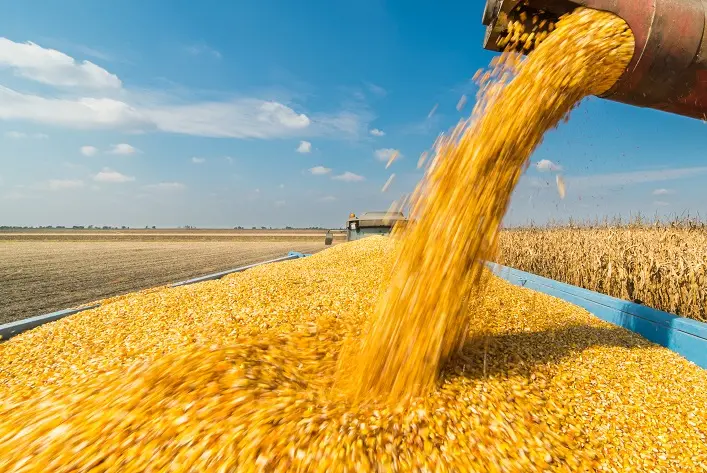Türkiye continues to assert its position as a major player in global agriculture, ranking among the top three producers in 22 agricultural products, according to data from the Turkish Agriculture and Forestry Ministry.
With nearly 150,000 square miles of fertile agricultural land, Türkiye produces a wide variety of crops, including vegetables, fruits, and grains, The Caspian Post reports, citing Anadolu.
The country leads the world in the annual production of hazelnuts, figs, apricots, poppy seeds, cherries, quinces, and carobs.
Türkiye ranked first worldwide in apricot production, with 750,000 tons, followed by Uzbekistan with 500,545 tons, Iran with 318,475 tons, Italy with 207,190 tons, and Algeria with 200,566 tons, the data showed.
Türkiye produced 736,791 tons of cherries, accounting for 25% of the world’s cherry production of 2.9 million tons, coming in first place. The country was followed by China with 465,348 tons, the US with 321,420 tons, Uzbekistan with 218,867 tons, and Iran with 144,877 tons.
Türkiye also ranked first in fig production with 350,000 tons produced annually, followed by Egypt with 193,058 tons, Morocco with 119,167 tons, Algeria with 116,183 tons, and Iran with 73,483 tons.
Meanwhile, Türkiye produced over half of the world’s hazelnuts at 650,000 tons on an annual basis out of the 1.1 million tons worldwide, followed by Italy with 102,740 tons, the US with 85,460 tons, Azerbaijan with 75,409 tons, and Chile with 65,647 tons.


By 2028, Kazakh agricultural producers may increase sunflower sowing areas to 2.73 million ha (compared to 1.77 million ha this year). This forecast was voiced by the chairman of the National Oilseed Processors Association (NOPA), Yadykar Ibragimov, at the international conference AgroFood Summit 2025 in Mersin (Turkey).
He noted that compared to 2021, the sunflower sowing area in Kazakhstan increased by 85%. This result is an outcome of the diversification of farmland in favor of more profitable crops, Y. Ibragimov stressed. The demand for oilseed raw materials keeps growing — Kazakhstan is actively increasing processing and export of fat-and-oil products.
“Since 2023, we have entered the Top 10 suppliers of sunflower oil in the world, taking 8th place based on the results of the 2023/24 season. Kazakhstan has also entered the Top 3 suppliers of sunflower meal to the European Union. We plan, in the mid-term, to enter the Top 3 global exporters of sunflower oil,” the head of NOPA said.
According to him, this will make it possible to increase foreign exchange earnings to $2 billion.
The speaker clarified that in 2024 Kazakhstan became the main supplier of vegetable oils to Uzbekistan and Tajikistan, surpassing Russia, which had previously led these markets. The share of Kazakh oil in the Uzbekistan market reached 65% (compared to 13% in 2017), and in Tajikistan — 74% (in 2017 — 15%).
“We fully supply the Central Asian countries with sunflower meal and cake, which are important resources for the sustainable development of poultry and livestock farming,” Y. Ibragimov emphasized.
In addition, according to NOPA, the current export of sunflower oil exceeds the demand for this product in the Central Asian countries by 1.5 times, and if necessary Kazakhstan can fully supply this market.
During the Food from Ukraine 2025 conference, Ukraine’s Deputy Minister of Economy, Environment and Agriculture, Taras Vysotsky, met with the UAE’s Deputy Minister of Foreign Affairs, Sultan Al Shamsi, to discuss the creation of agricultural hubs in the UAE. This was reported by Ukraine’s Ministry of Economy.
“This will optimise logistics and increase the efficiency of food delivery to those who need it most,” the Ministry said in a statement.
The agricultural hubs will receive Ukrainian products for packaging and distribution to countries in need, including Gaza, Sudan, Kenya, Somalia, and other regions.
“Ukraine has long played a key role in global food security and is a reliable partner for the countries of the Global South. Despite the war and Russia’s attempts to hinder our exports, since 2022 we have supplied more than 40% of Ukrainian grain exports to Asia, Africa, and Latin America. We do not just deliver food, but also offer technologies, experience, and production models that ensure long-term food stability,” emphasised Taras Vysotsky.
Earlier, the Ministry of Economy, Environment and Agriculture of Ukraine and the Ministry of Food and Agriculture of the Republic of Ghana signed a memorandum of understanding to establish a centre for processing and distributing Ukrainian products in West Africa.
The Food from Ukraine 2025 conference brought together more than 100 official and business delegations, including representatives from African countries, international organisations, and Ukrainian manufacturers of agricultural machinery and food products.


The European Union (EU) has approved a new plant sterol sourced from sunflowerseeds produced by US speciality ingredients company Kensing.
The European Food Safety Authority (EFSA)’s approval through its Novel Food application process granted Kensing commercial exclusivity for Sunvasterol in Europe, the company said on 11 November.
Sunflower phytosterols offered food formulators and dietary supplement brands an alternative to traditional soya, rapeseed and pine-based sterols, Kensing said.
“The EFSA approval confirms that sunflower-derived phytosterols deliver a strong cholesterol-lowering benefit, similar to our other EFSA-approved sterols,” said Serge Rogasik, Kensing CEO.
Kensing’s Sunvasterol product is produced from a byproduct of sunflower oil at the company’s facilities in Valencia and Talavera de la Reina, Spain.
Sunvasterol is composed of concentrated phytosterols (primarily beta-sitosterol, stigmasterol and campesterol) in the form of free sterols and sunflower lipid-linked esters. Esterification significantly increases the fat-solubility of plant sterols.
Available as free sterols or fat-soluble esters, Kensing said as well as being used in supplements, the product could be incorporated into fat-containing foods, including margarines and spreads, yogurts, functional dairy drinks, and other dairy products, milk-analogue products, condiments and salad dressings.
Phytosterols are a natural lipid component of oil seeds, grains, nuts, legumes and other plant seeds. They reduce cholesterol by competing with dietary and biliary cholesterol for absorption in the intestines, lowering the amount of cholesterol entering the bloodstream. This absorption inhibition helps to reduce total and LDL-cholesterol levels.
Sunflower phytosterols were supported by EFSA-approved health claims indicating that a daily intake of 1.5g-3.0g could help reduce total and LDL cholesterol by about 7%-12% over 2-3 weeks when incorporated into authorised food categories.
Prime Minister Yulia Svyrydenko stated that, despite the war, Ukraine remains a key player in the global food market. This season, the country will supply 36% of worldwide sunflower oil exports and over 12% of global corn exports.
Svyrydenko added that immediately after the full-scale invasion began, Ukraine launched the Grain from Ukraine humanitarian initiative, which fed millions in Africa and the Middle East. She emphasized that since the war began Ukraine has exported over 66 million tons of food to Asia, Africa, and the Middle East.
The Ministry of Economy reported that in the current marketing year Ukraine has already exported 5.8 million tons of wheat. Ukraine is also among the top six global exporters of chicken.
Meanwhile, this year’s corn harvest could be the largest in the last four years with 31 to 31.5 million tons, roughly 50% of all grain crops. The forecast from the United States Department of Agriculture (USDA) even reaches 32 million tons. It is expected that Ukraine’s corn exports will total about 24.5 million tons.


The Lecithin market has witnessed significant growth in recent years, driven by its diverse applications across various industries, including food, pharmaceuticals, and cosmetics. This multifunctional ingredient is essential for enhancing the texture and stability of products, making it a critical component in numerous formulations. The Global Lecithin Market size is estimated to be valued at USD 1.5 billion in 2025 and is expected to reach USD 2.3 billion by 2032, exhibiting a compound annual growth rate (CAGR) of 6.5% from 2025 to 2032.
➤ Strategic Actionable Insights for the Market:
The growing demand for natural emulsifiers in food and beverages is a key driver of the Lecithin market. Recent data indicates that the clean label trend is gaining momentum, with over 60% of consumers preferring products with natural ingredients. This shift is pushing manufacturers to incorporate Lecithin as a preferred emulsifier. An increase in health-conscious consumers is leading to a rise in the demand for Lecithin in Food supplements. In 2024, the food supplement segment accounted for approximately 30% of the Lecithin market share, highlighting the importance of this ingredient in enhancing nutrient absorption and overall health benefits. The expanding applications of Lecithin in the pharmaceutical sector are contributing to market growth. The global pharmaceutical industry is projected to grow at a CAGR of 4.8% between 2025 and 2032, with Lecithin being utilized in drug formulations for its ability to improve bioavailability and stability. Technological advancements in extraction and processing methods are enhancing the quality and yield of Lecithin products. Companies investing in innovative processing techniques have reported a 20% increase in production efficiency, further solidifying their market position.
The index tracks changes in the international prices of the most globally traded food commodities.
The FAO Vegetable Oil Price Index averaged 169.4 points in October, up 1.5 points (0.9%) from September and reaching its highest level since July 2022. The increase reflected higher quotations for palm, rapeseed, soyabean and sunflower oils.
“International palm oil prices rebounded slightly after easing the previous month, supported by expectations of tighter exportable supplies following Indonesia’s planned increase in biodiesel blending mandates in 2026, and despite higher-than-expected production in Malaysia,” the FAO said.
“World sunflower oil prices rose for the fourth consecutive month in October, largely due to limited supplies from the Black Sea region amid harvest delays and cautious farmer sales.”
Meanwhile, global rapeseed and soyabean oil prices increased due to persistent tight supplies in the European Union (EU) and higher domestic demand in Brazil and the USA respectively.
The increase in vegetable oil prices was outweighed by lower price indices for cereals, dairy products, meat and sugar.
The FFPI averaged 126.4 points in October 2025, down 2.1 points (1.6%) from the revised September level of 128.5 points, marking its second consecutive monthly decline.
Overall, the FFPI was slightly below its October 2024 level and remained 33.8 points (21.1%) lower than its peak in March 2022.
The FAO’s vegetable oil price index illustrates the changes in international prices of the 10 most important vegetable oils in world trade, weighted according to their export shares.


According to estimates by the EU Commission, sunflower seed production in the EU in 2025 is expected to total just over 8.5 million tonnes.
This represents a 3% rise on the disappointing 2024 harvest. The higher yield could partly offset the slight decline in area within the EU. Nevertheless, the harvest remains the third smallest in the past 10 years.
Although yields are forecast to exceed last year's levels, averaging 18.0 decitonnes per hectare, they remain well below the long-term average of 20.1 decitonnes per hectare.
In 2024, yields reached only 17.4 decitonnes per hectare. The EU's sunflower area has been reduced slightly, by around 0.5%, to just under 4.8 million hectares.
Romania remains the leading sunflower-producing country in the EU-27, with a reduced production area of 1.2 million hectares.
Yields are projected to slightly surpass last year's levels but to remain below average. Production is expected to reach 1.7 million tonnes, a significant year-on-year increase from 1.5 million tonnes.
With an expected harvest volume of nearly 1.8 million tonnes, Hungary is set to retain first place among the EU's major sunflower producers for the second consecutive year.
According to research by Agrarmarkt Informations-Gesellschaft (AMI), the sunflower area in Germany expanded again in 2025, after two years of decline. At 61,000 hectares, the area planted with sunflowers remains well above the level recorded before Russia's attack on Ukraine.
In the wake of the aggression, many German farmers significantly expanded their sunflower areas in 2022. For comparison, in 2020 the total area under sunflowers was only 28,000 hectares. Thanks to the increase in area, Germany's 2025 harvest is expected to reach about 150,000 tonnes, representing a rise of around 16,000 tonnes compared to 2024.